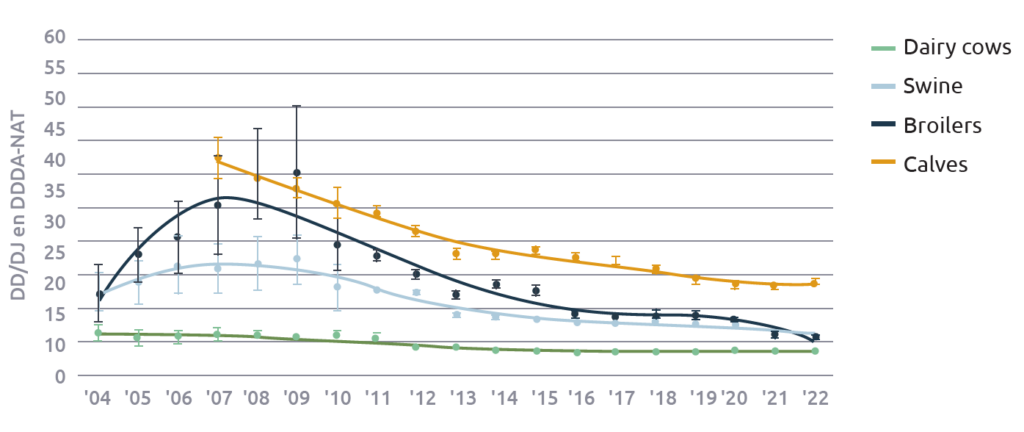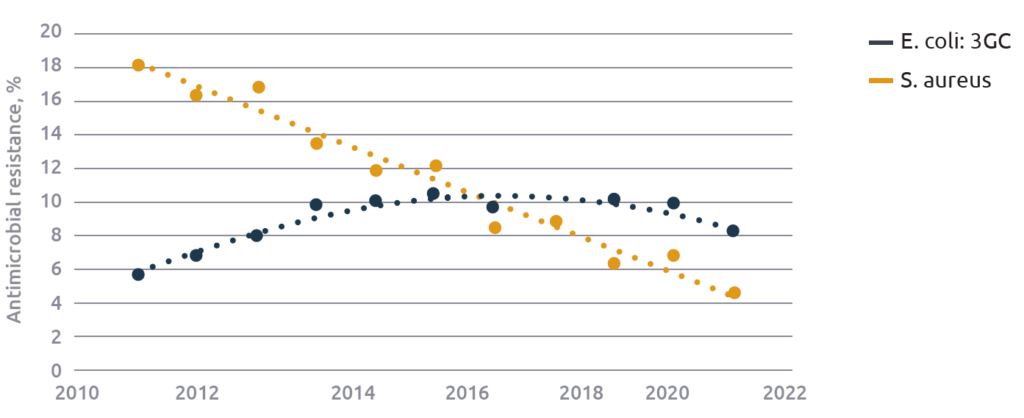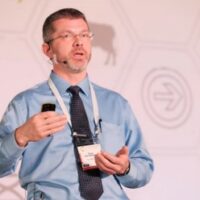By Theo van Kempen (Global tech lead pigs)
In response to concerns about antimicrobial resistance in humans, governments worldwide have taken decisive steps to limit the use of antibiotics in livestock. This shift has been particularly evident in the European Union, where prophylactic use of antibiotics has been banned since 2006. Because several countries have closely monitored the effects of this ban, we can now draw interesting lessons from objectively gathered data.
The Netherlands: a temporary rise followed by remarkable reductions
In the Netherlands, data show an initial increase of antimicrobial use in livestock immediately after the ban in 2006. (e.g., from 30.5 to 36.5 days of treatment per year in broilers, as seen in Figure 1). This rise can be attributed to a shift from preventive in-feed use to curative use, with subsequent higher doses. However, this surge proved temporary, and was followed by an impressive 80% reduction in broilers, dropping to 5.8 days of treatment per year (Figure 1).

Figure 1: Antibiotic usage in the Netherlands (in days treated per year; SDa report, 2023)
Belgium and France: up to 60% drop in antibiotic use
Belgium witnessed a substantial reduction, with total antibiotic use plummeting nearly 60%, from almost 150 mg/kg biomass in 2011 to 61.4 mg/kg biomass in 2020 (BelMapdata2023). Similar positive trends were observed in France for pigs and poultry (Santé Publique France, 2023). For comparison: data on antimicrobial consumption in dogs and cats remained relatively stable between 2012 and 2022.
Human medicine vs. livestock advancements
While livestock industries celebrate significant strides, human medicine faces challenges. Antibiotic prescriptions in France, for instance, declined during the COVID-19 pandemic but have rebounded to an average of nearly 1 antibiotic prescription per person each year. Data from Belgium also fail to show clear improvements in the use of antimicrobials for humans.
Analyzing mixed data on antimicrobial resistance
Data on antimicrobial resistance in humans present a mixed picture. While E. coli resistance against 3rd generation cephalosporins increased in Belgium, Staphylococcus aureus resistance against methicillin decreased by 75% (Figure 2).

Figure 2: Antibiotic resistance in humans in E. coli against 3rd generation cephalosporins and Staphylococcus aureus against methicillin as measured in Belgium (BelMapdata 2023)
Similar patterns emerge in France, showcasing varying responses in different species.
While antimicrobial resistance did not change dramatically in humans and horses, resistance in pigs decreased by over 80%. The reduction for poultry was even stronger, dropping from over 10% in 2012 to less than 1% in 2022.


Figure 3: Antibiotic resistance in people and animals (reproduced after data from France)
Sustainable strategies in agriculture
Efforts to further reduce antimicrobial use in agriculture remain robust. In the Netherlands, for instance, farms that exceed certain predefined antibiotic use thresholds undergo intervention programs. In addition, these thresholds are lowered over time. Initiatives such as these showcase the industry’s commitment to sustainable solutions, from biosecurity measures to feed additives that enhance animal health.
Acknowledging progress and charting the path forward
We can clearly conclude that aligning livestock practices with strategic antibiotic management not only yields positive results for the agriculture industry itself. It also offers valuable insights for human medicine’s approach to antimicrobial resistance. While applauding the advancements made in animal agriculture, it’s crucial for human medicine to address similar challenges and to draw inspiration from agricultural evolutions. Maintaining our focus on strategic antibiotic management, let’s foster collaboration and mutual learning to achieve sustainable agricultural success and at the same time safeguard global health.
Contact your agrimprove expert
Do you have a question or want personalized advice? Your Agrimprove expert is willing to help. Reach out directly or request to be contacted at your convenience.
